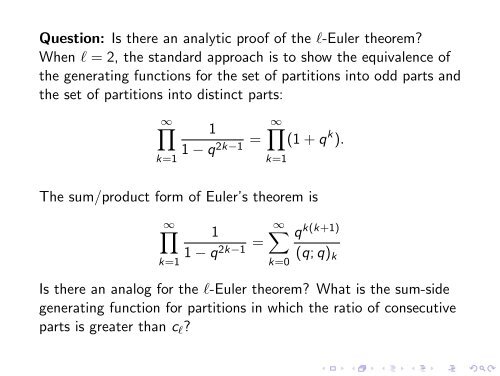Euler's partition theorem and the combinatorics of -sequences
Euler's partition theorem and the combinatorics of -sequences Euler's partition theorem and the combinatorics of -sequences
Another q-analog of the l-nomial Let a n (q) = (1 − q an )/(1 − q). Then [ n k ] (l) q = ∑ (µ,f ) q shapeweight(µ) q fillweight(µ,f ) where the sum is over all pairs (µ, f ) such µ is a partition in [k × (n − k)] and f is a filling f (i, j) of the cells of [k × (n − k)] with elements of {0, 1, . . . l − 1} so that (i) no row of µ or column of µ c contains (l − 1)(l − 2) ∗ (l − 1) and ... (a bit more) Indexing cells of k × (n − k) bottom to top, left to right: ◮ cell (i, j) has a shape weight (a i − a i−1 )(a j − a j−1 ) ◮ shapeweight(µ) is sum of shape weights of cells in µ ◮ cell (i, j) has a fill weight a i a j ◮ fillweight(µ, f ) is ∑ i,j f (i, j)a ia j . (Now starting to get something related to lecture hall partitions.)
Question: Is there an analytic proof of the l-Euler theorem? When l = 2, the standard approach is to show the equivalence of the generating functions for the set of partitions into odd parts and the set of partitions into distinct parts: ∞∏ 1 ∞ 1 − q 2k−1 = ∏ (1 + q k ). k=1 k=1 The sum/product form of Euler’s theorem is ∞∏ k=1 1 ∞ 1 − q 2k−1 = ∑ k=0 q k(k+1) (q; q) k Is there an analog for the l-Euler theorem? What is the sum-side generating function for partitions in which the ratio of consecutive parts is greater than c l ?
- Page 9 and 10: Sylvester’s Bijection
- Page 11 and 12: l-sequences For integer l ≥ 2, de
- Page 13 and 14: l-sequences For integer l ≥ 2, de
- Page 15 and 16: l = 2 The l-Euler theorem [BME2]: T
- Page 17 and 18: l = 3 The l-Euler theorem [BME2]: T
- Page 19: The insertion step To insert a k +
- Page 22 and 23: Binary numeration system 1 0 1 1 0
- Page 24 and 25: Binary numeration system 1 0 1 1 0
- Page 26: Theorem [Fraenkel 1985] Every nonne
- Page 31 and 32: Lecture Hall Partitions
- Page 33 and 34: The Lecture Hall Theorem [BME1] The
- Page 35 and 36: Θ (l) n : Bijection for the l-Lect
- Page 44 and 45: Truncated lecture hall partitions L
- Page 46 and 47: Theorem [Corteel,S 2004] Given posi
- Page 48 and 49: The l-nomial coefficient Example (
- Page 50 and 51: Let u l and v l be the roots of the
- Page 52 and 53: Let u l and v l be the roots of the
- Page 54 and 55: An l-nomial theorem [LS]: An analog
- Page 56 and 57: A coin-flipping interpretation of t
- Page 58 and 59: Define a q-analog of the l-nomial:
- Page 62 and 63: Question: When l = 2, several refin
- Page 64 and 65: Question: What is the generating fu
- Page 66 and 67: CanaDAM 2009 2nd Canadian Discrete
Question: Is <strong>the</strong>re an analytic pro<strong>of</strong> <strong>of</strong> <strong>the</strong> l-Euler <strong><strong>the</strong>orem</strong>?<br />
When l = 2, <strong>the</strong> st<strong>and</strong>ard approach is to show <strong>the</strong> equivalence <strong>of</strong><br />
<strong>the</strong> generating functions for <strong>the</strong> set <strong>of</strong> <strong>partition</strong>s into odd parts <strong>and</strong><br />
<strong>the</strong> set <strong>of</strong> <strong>partition</strong>s into distinct parts:<br />
∞∏ 1<br />
∞<br />
1 − q 2k−1 = ∏<br />
(1 + q k ).<br />
k=1<br />
k=1<br />
The sum/product form <strong>of</strong> Euler’s <strong><strong>the</strong>orem</strong> is<br />
∞∏<br />
k=1<br />
1<br />
∞<br />
1 − q 2k−1 = ∑<br />
k=0<br />
q k(k+1)<br />
(q; q) k<br />
Is <strong>the</strong>re an analog for <strong>the</strong> l-Euler <strong><strong>the</strong>orem</strong>? What is <strong>the</strong> sum-side<br />
generating function for <strong>partition</strong>s in which <strong>the</strong> ratio <strong>of</strong> consecutive<br />
parts is greater than c l ?



